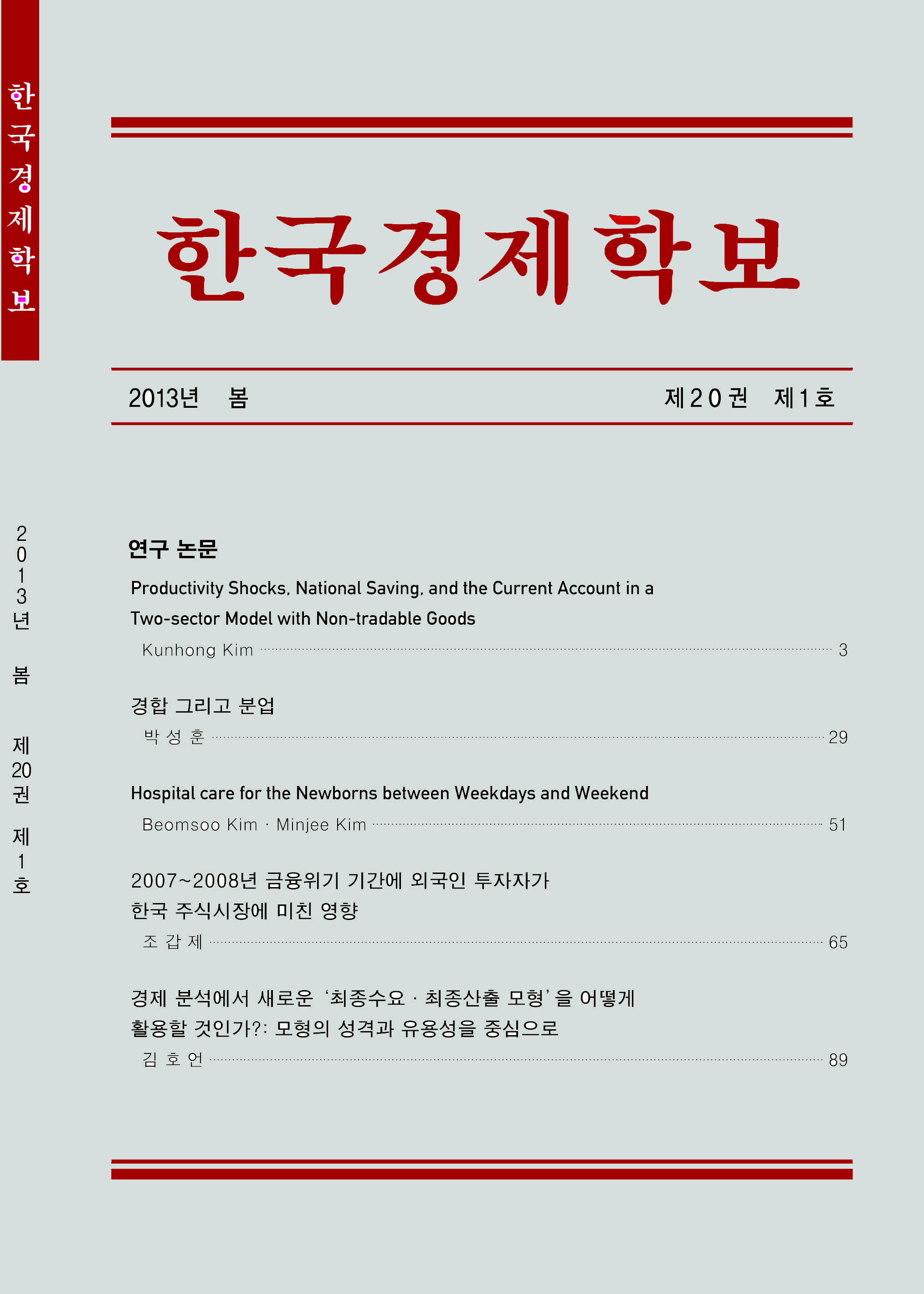
한국경제학보 제 10권, 제 1호 (2003년 봄)
연구논문
Jae Hyeong Kang, Sanghack Lee, Sanghoon Lee
Pages 1-8
-
Abstract || PDF
- This note derives optimal competition policy for export marketing boards dealing with many products. The optimal number of export boards is shown to one plus the ration of weighted sum of the slopes of export supply curves relative to weighted sum of the slopes of import demand curves. Utilizing graphic methods. this note also discusses the effects of fixed costs on the optimal number of export marketing boards.
Doo Won Lee, Sang Jin Han
Pages 9-35
-
Abstract || PDF
- Estimating the relative size of the shadow economy, which is often called an underground economy, is important in any country to make effective economic decisions. In particular, it can be crucial to understanding the economic performance of North Korea. whose official economic sector is rapidly dismantling. This paper tried to estimate the relative size of the North Korea shadow economy and therefore defining the shadow economy as all economy. This paper introduced the current status of the North Korean shadow economy as well as some backgroud infromationg behind it. Beginning with the estimates made rule of thumb, this paper employs three different methods to estimate the relative size of the North Korean shadow economy as of 1999. First, it tries to sum up individual shadow economic sectors based on various sources. Assuming that there are three supply routes for the shadow economy, this paper estimated each of them and adds them up. According to this method, the shadow economy is accounting for at least 12.2% of GDP. Second, by relying on surveys recently conducted with North Korean refugees, it tried to estimate the shadow economy by examining the differences between income and expenditure levels of North Korean households. This method estimates the North Korean shadow economy to be as big as 11.5% of its GDP. Third, assuming that electricity consumption is the single most important physical indicator that can explain the growth of an overalll economy. this paper estimated the overall size of the North Korean economhy first. After that, it calculated the size of the shadow economy by subtracting the officail GDP from the overall GDP. This method can be regarded as the most rigorous method. and it estimated the North Korean shadow economic size, which is the estimate of the North Korean shadow economic size, which is approximately 12% of its official economic size as of 1999. But, it has to be noted that most of these estimations are based on the assumptions that can estimate the shadow economic size at its minimum level. Therefore, it is very likey that the actual size of the North Korean shadow economy can be slightly larger thatn these estimations.
정진욱
Pages 37-52
-
Abstract || PDF
- TV 프로그램의 성격과 시청자의 사회·경제적 특성에 따른 채널 선택 유형을 분석하고 시청률의 결정요인을 실증적으로 연구하는 것은 광고매체의 효율적 선택과 광고효과의 정확한 예측을 위하여 매우 중요한 작업이다. 이 연구는 회귀부석을 통하여 우리나라 TV시청자들의 프로그램 선택에 영향을 끼치는 요인들을 식별하고 그 영향의 정도를 추정함으로써 38개 시청자 유형별 시청률 예측모형을 구축한다. 분석 결과 프로그램의 시청점유율에 영향을 미치는 요인은 프로그램 유형, 방영시간대, 프로그램의 질, 채널충성도 등인 것으로 식별되었으나, 시청률 결정요인 및 모형의 예측력은 시청자 유형별로 매우 상이하게 나타났다.
김학은
Pages 53-96
-
Abstract || PDF
- 본 논문은 김학은 [1]의 후속이며 동시에 김학은 [3]의 결과를 전혀 다른 방법으로 재확인하는 논문이다. 이 논문에서 강수량효과를 이용하여 약수량효과를 재확인한다. 그 과정에서 본원공간과 쌍대공간을 동시에 만족시키는 약확장경로를 새롭게 조명하였다.
강의자료
The Korean Journal of Economics, Vol. 10, No. 1 (Spring 2003)


